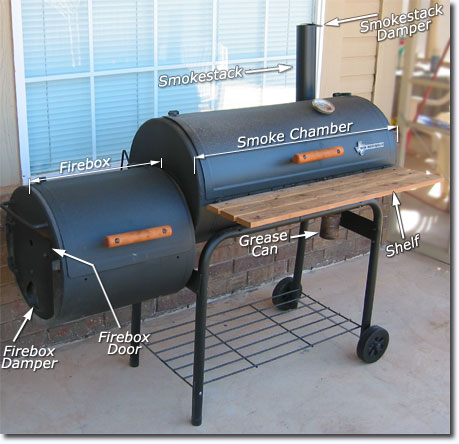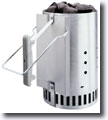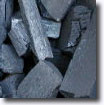Since I suspect that many visiting this site might be new to smoking and in particular smoking with an "Offset Smoker" I am going to outline some of the basics and misconceptions that tend to be presented to all of us starting out.
WHAT IS
BARBECUE?
Most
important, BBQ or Barbecue is NOT "grilling." You "grill"
when you cook hamburgers outdoors. Although the Barbecue term is somewhat
regional, you will find cookbooks, places on the Internet, etc. that refer
to "Barbecuing" when it really means grilling. Most everyone
has invited guests over for a Barbecue and it was clear the results would
end up cooking hamburgers and possibly hotdogs. While there are many definitions
and opinions, for the purpose of this site, Barbecue (or BBQ) means smoking
over low heat (usually around 220 degrees but the government
recommends 250° to 300° F for safety) and with at least some
wood.
To add to the confusion, the Silver Smoker and most offset smokers will refer to grilling. Typically this is just an extra grate placed directly over the fire in the firebox. Keep in mind that this is a "sales" thing that adds another "feature" to your smoker. In other words, you can also grill hamburgers as well as smoking meats. The feature is a good feature but not the main purpose of the smoker. Grilled meat cooked over charcoal and wood make for an excellent taste, not found in the typical gas grills. For the purpose of this site I will only consider the smoker for smoking foods and not for grilling.
THINGS
THAT YOU DON'T DO
Some things that everyone agrees on are few and far between. Here
are a few:
- Starting Fluid is a no-no. Don't use it. If you have, don't admit it. Use a "Charcoal Chimney Starter" instead.
- Don't use Self-lighting briquettes. Use a "Charcoal Chimney Starter" instead.
- Don't use just "any old kind" of wood. What might be appropriate for your fireplace might not be good for your smoker. Some manufacturers believe that using the wrong firewood will create a permanent off-taste in the smoker that is near to impossible to eliminate. For now, use commercial woods found at the store designated for the purpose of smoking meats. You will learn later what woods are good and which ones are bad. If you can't wait, take a look at this page for a general overview and at this page for a detailed description. The two most common "types" of woods for smoking are Hickory and Mesquite.
- Don't keep opening the smoke chamber and fiddling with the meat.
- Don't underestimate the "wind." Oxygen is part of the fuel and wind can have a dramatic effect of temperature control. If a smoker is usually too hot, face the smoker so the Firebox Damper is away from the wind. If it is the reverse, position the smoker so the Firebox Damper is into the wind. If you have no problem with too hot or too cold of a smoker, then position the smoker at a 90° angle to the wind and you will have consistent results that you can rely on regardless of wind direction. Position the smoker before you load the charcoal basket and don't change its position during the smoking process.
SMOKER
PARTS

A DAMPER
THAT ISN'T A DAMPER
On
every offset smoker there is a smokestack "damper." The manufacturers
point to this feature as a way to control smoke and temperature. In reality,
all the pros consider this "damper" to be nothing more than
a "cover." When smoking you leave it "wide open."
You never partially close the smokestack damper when smoking. You control
the temperature with the "Firebox damper" and leave the smokestack
damper wide open.
There are many discussions that you'll find on this subject and generally the thoughts are that when you partially close the smokestack damper, it creates "creosol" (creosote) on the meat. Whether this is creosote or not, the results are a bitter taste to your meats. Use the smokestack damper to keep out bugs and rain when not in use.
MANY OF
THE SAME STYLE
The
Silver Smoker is interesting since I've seen at least three different
brands that look identical in design. There are some subtle differences,
but for the most part, the structural design varies little. Other similar
smokers are the Hondo, Black Diamond and Brinkman Smoke 'n Pit (SnP).
There seems to be many more "no-name" brands that are likely
made by one of these companies. Char-Broil has bought out New Braunfels,
so Char-Broil is also selling the Silver
Smoker under the same model name. I believe the basic design can be
attributed to the New Braunfels Smoker Company and distributed by Char-Broil
under many different names.
DIFFERENCES
ABOUND
Like
politics and religion, you should be aware that everyone is not in full
agreement on smoking techniques. I will outline the most common differences
and expand on them somewhat.
Water
Some people have strong faith in using water while smoking and others see it of little or no use. One group strongly believes that water adds tenderness to the meat and the other group believes that it adds nothing. Also in these two groups, there is a general consensus that water helps to maintain the temperature stability. For the most part, those that don't see water as a benefit believe that you can help to make the temperature stable by using "sand" in your water-pan instead of water. I tend to believe that it adds nothing to the tenderness of the meat, but does help to stabilize the smoker temperature for hot spikes. I am still testing the advantage of water and for now, will fluctuate between using water and not using water.Aluminum Foil Wrap
Some believe that wrapping meat in foil at any point during smoking is a crime. Many believe that wrapping brisket and ribs at some point during the cooking process produces tender meat. I like to wrap my brisket with foil during the last few hours of cooking and keep it wrapped until it cools. I also like the method that the administrator, Kevin, over at HomeBBQ.com uses for ribs. It is called a "3-2-1 method." You smoke for 3 hours unwrapped, 2 hours wrapped in foil, and then 1 hour unwrapped again. Another method and works for baby back ribs is the 3-1-1 method.All Wood Smoking
Some believes that you should only use 100% wood for smoking. Others believe that you should use very little wood (mixture of charcoal and wood), as the flavor is too strong. I think that this has a lot to do with the smoker that you are using. The expensive smokers "breath" a lot better than the discount offsets and allow for a cleaner burn of 100% wood. Even this modified and tuned smoker tends to make the meat too "smoky" in my opinion. I use about a 10% mixture of wood to charcoal (10% wood 90% charcoal). I concentrate on burning wood or wood chips at the beginning of the smoking process. Also understand that there are some people that burn 100% charcoal with no wood. Keep in mind that the slow cooking of meats on the smoker can extend up to many hours absorbing the flavors verses grilling a steak for a few minutes over charcoal.Bark On The Wood
Some think you should never use wood with bark on the outside due to giving an off-flavor. Others think that it enhances the flavor or makes no change to the meat smoke flavor. I don't have an opinion about this but tend to use wood bark before I place the meat in the smoker or while the meat is wrapped in foil.Types Of Charcoal
Charcoal is wood that is heated in ovens that contain little or no air, causing the hydrogen, nitrogen, and oxygen in the wood to escape, leaving behind black, porous charcoal.Hardwood Lump Charcoal is solid pieces of hardwood treated as above. They can not be damaged by water and will return to their original characteristics once dried out.
BriquettesThe standard charcoal is the briquette and Kingsford is the standard brand name that makes this type of charcoal. Making the shape into a briquette requires grinding and shaping with some bonding agent. Typically this bond is made by "clay" soil. These briquettes can be damaged by moisture and may not return to its natural shape once dried out.
Many pros believe in using only Lump Charcoal. It is considered cleaner burning, hotter, added flavor, less ash, and in most cases as easy or easier to light than briquettes. Some are sold on a certain type of wood used to make the Lump Charcoal and some are sold on a particular brand.
Lump CharcoalMore than likely you've seen lump charcoal in stores but were not aware that it was different. Most beginners would consider it just another "off-brand" form of briquettes. However, lump charcoal has irregular shapes and look like burnt pieces of wood once you open the bag. There is not a "standard" brand as there is with Kingsford, but all bags will have, "Lump Charcoal" or "Hardwood Charcoal" with "natural" typically printed somewhere on the bag. The larger Wal-Marts and hardware stores carry the lump charcoal. (Don't confuse "pellet charcoal" with lump charcoal. Pellet charcoal is used for a specific purpose for unattended automatic firebox feeders.)
I personally use a little of both (not usually on this site or for testing). I use briquettes for lining the bottom of my fire basket and in the starter chimney. I use lump charcoal to fill the rest of the basket. Besides lump charcoal burning hotter, due to its irregular shape, it allows much better airflow and may get very hot. This is particularly noticeable when adding just a few chunks at a time verses having a basket somewhat packed and settled with lump charcoal beforehand. I use a combination of lump charcoal and wood to control the temperature once the basket is well lit.
Kingsford, a Clorox company, has a very interesting history.
Minion Method
The Minion Method was named after Jim Minion and made famous on the Weber Bullet. This is a way that you load and burn the charcoal. The result of this method is long, consistent burn times over many hours. In this method you load unlit Kingsford and then put a chimney of lit Kingsford on top. This makes for a very long burn with little or no attention to the fire. For unattended low temperature smoking this seems to be an accepted method by most. Some believe that they can sense an off-taste due to the unburned briquettes. For me, this is a very desirable method but at this point, the way my fire basket is designed, it does not work well and I suspect that I will be making more mods to accommodate this method. I use a somewhat modified Minion Method that I will describe elsewhere on this site.
FOOD
SAFETY
Review the government's publication on Barbecue
Food Safety or print the brochure
in Adobe PDF format. For my tuning, I used three digital thermometers.
The thermometer that comes with most smokers are mounted in the top of
the smoke chamber and generally read higher than at the "meat level."
I always use a digital thermometer to check the internal temperature of
the meat to check for doneness.


